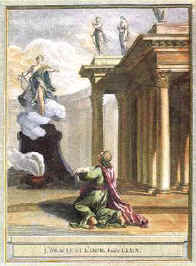

Be careful what you wish for
D Vautier
11/2013
In my somewhat abbreviated liberal arts education I never really had much of a chance to notice the Roman writer Petronius Arbiter of "cave canem" fame. His signature inscription was first known to me in Eliotís introduction to The Waste Land. It describes an incident where the sun god Apollo presented his love to the sibyl of Cumae. For some reason she did not accept so he instead offered her an opportunity to live for 1000 years which she agreed to. She did live for 1000 years but only to wither away becoming a mere small suffering creature. So Petronius says..
Nam
Sibyllam quidem Cumis ego ipse oculis meis
vidi in ampulla pendere, et com illi pueri dicerent:
zSibulla ti qeleiz:
respondebat illa:
apoqanein
qelo.
In
his book The Day of Battle, p. 351, Rick Atkinson expands more
about Cumae, the site of the unfortunate oracle and brings up it's long
and storied history. Aeneas came ashore at Puteoli, now known as
Pozzuoli, not too far west of Naples, where he was to have entered the
underworld, crossing the river Styx, and visiting the souls of the dead,
more obviously to visit Dido, the woman who had died for his love and to
whom he he needed to do a lot of "splain'in". The remark from
Virgil in book VI makes it clear that his visit was exactly about
"wasting sickness and cruel love".
Atkinson uses this as a parallel for the Anzio invasion preparation, one that was considered almost sure to fail and almost did.
I don't know what is so extremely captivating to me about this? When I was about 10 years old I read a science fiction story about a transparent missile that crashed on earth and inside was an alien unable to get out. Many scientists worked long and hard to discover what was going on until they decided to blow the thing back into space and many people wondered why. The scientists concluded that the creature was carrying a virus. That virus was immortality.